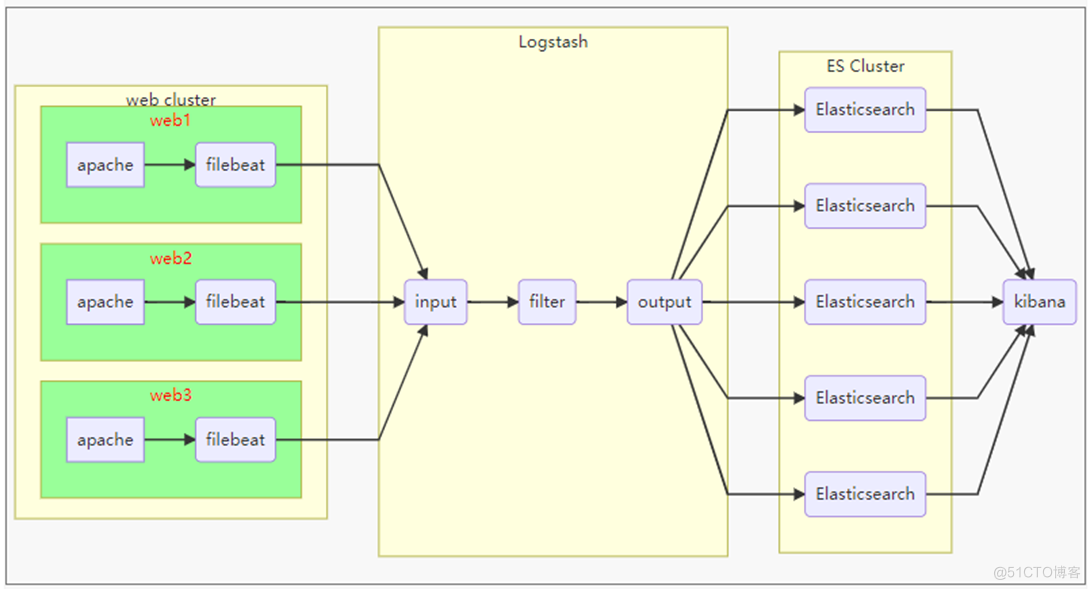架构图

一、环境准备
1.主机清单
主机名 | IP地址 | 配置 |
es-0001 | 192.168.1.41 | 1cpu,1G内存,10G硬盘 |
es-0002 | 192.168.1.42 | 1cpu,1G内存,10G硬盘 |
es-0003 | 192.168.1.43 | 1cpu,1G内存,10G硬盘 |
es-0004 | 192.168.1.44 | 1cpu,1G内存,10G硬盘 |
es-0005 | 192.168.1.45 | 1cpu,1G内存,10G硬盘 |
Kibana | 192.168.1.46 | 1cpu,1G内存,10G硬盘 |
logstash | 192.168.1.47 | 2CPU、2G内存,10G硬盘 |
apache | 192.168.1.48 | 1PU、1G内存,10G硬盘 |
2.软件清单
- elasticsearch-2.3.4.rpm
- logstash-2.3.4-1.noarch.rpm
- kibana-4.5.2-1.x86_64.rpm
- filebeat-1.2.3-x86_64.rpm
3.插件清单:
- [x] elasticsearch插件:
软件包 | 描述 |
| bigdesk-master.zip | 是ES集群的监控工具 |
| elasticsearch-kopf-master.zip | 一个ElasticSearch的管理工具,提供对ES集群操作的API |
| elasticsearch-head-master.zip | 展现ES集群的# 显示帮助信息 ?help拓扑结构,可进行索引(index)、节点(node)级别的操作 |
4.华为云跳板机
配置yum软件仓库:
[root@ecs-proxy <sub>]# rm -rf /etc/yum.repos.d/*.repo
[root@ecs-proxy </sub>]# curl -o /etc/yum.repos.d/CentOS-Base.repo http://mirrors.myhuaweicloud.com/repo/CentOS-Base-7.repo
[root@ecs-proxy <sub>]# yum clean all
[root@ecs-proxy </sub>]# yum makecache
[root@ecs-proxy <sub>]# yum install -y net-tools lftp rsync psmisc vim-enhanced tree vsftpd bash-completion createrepo lrzsz iproute
[root@ecs-proxy </sub>]# mkdir /var/ftp/localrepo
[root@ecs-proxy <sub>]# cd /var/ftp/localrepo
[root@ecs-proxy </sub>]# createrepo .
[root@ecs-proxy <sub>]# createrepo --update . # 更新
[root@ecs-proxy </sub>]# systemctl enable --now vsftpd
[root@ecs-proxy ~]# cp -a elk /var/ftp/localrepo/elk
[root@ecs-proxy elk]# cd /var/ftp/localrepo/
[root@ecs-proxy localrepo]# createrepo --update .
优化系统服务
[root@ecs-proxy <sub>]# systemctl stop postfix
[root@ecs-proxy </sub>]# yum remove -y postfix firewalld-*
[root@ecs-proxy <sub>]# yum install chrony
[root@ecs-proxy </sub>]# vim /etc/chrony.conf
# 注释掉 server 开头行,添加下面的配置
server ntp.myhuaweicloud.com minpoll 4 maxpoll 10 iburst
[root@ecs-proxy <sub>]# systemctl enable --now chronyd
[root@ecs-proxy </sub>]# chronyc sources -v //验证配置结果 ^* 代表成功
[root@ecs-proxy <sub>]# vim /etc/cloud/cloud.cfg
# manage_etc_hosts: localhost //注释掉这一行
[root@ecs-proxy </sub>]# reboot
安装配置ansible管理主机
[root@ecs-proxy <sub>]# cp -a ansible_centos7 /var/ftp/localrepo/ansible
[root@ecs-proxy </sub>]# cd /var/ftp/localrepo
[root@ecs-proxy <sub>]# createrepo --update .
[root@ecs-proxy </sub>]# vim /etc/yum.repos.d/local.repo
[local_repo]
name=CentOS-$releasever – Localrepo
baseurl=ftp://192.168.1.252/localrepo
enabled=1
gpgcheck=0
[root@ecs-proxy <sub>]# yum makecache
[root@ecs-proxy </sub>]# yum install -y ansible //去华为云网页下载秘钥,并上传秘钥到跳板机
[root@ecs-proxy <sub>]# mv luck.pem /root/.ssh/id_rsa
[root@ecs-proxy </sub>]# chmod 0400 /root/.ssh/id_rsa
5.华为云模板机(镜像)配置
[root@ecs-host <sub>]# passwd root
[root@ecs-host </sub>]# rm -rf /etc/yum.repos.d/*.repo
[root@ecs-host <sub>]# curl -o /etc/yum.repos.d/CentOS-Base.repo http://mirrors.myhuaweicloud.com/repo/CentOS-Base-7.repo
[root@ecs-host </sub>]# vim /etc/yum.repos.d/local.repo
[local_repo]
name=CentOS-$releasever – Localrepo
baseurl=ftp://192.168.1.252/localrepo
enabled=1
gpgcheck=0
[root@ecs-host <sub>]# yum clean all
[root@ecs-host </sub>]# yum makecache
[root@ecs-host <sub>]# yum repolist
[root@ecs-host </sub>]# yum install -y net-tools lftp rsync psmisc vim-enhanced tree lrzsz bash-completion iproute
优化系统服务
[root@ecs-host <sub>]# systemctl stop postfix atd tuned
[root@ecs-host </sub>]# yum remove -y postfix at audit tuned kexec-tools firewalld-*
[root@ecs-host <sub>]# yum install chrony
[root@ecs-host </sub>]# vim /etc/chrony.conf
# 注释掉 server 开头行,添加下面的配置
server ntp.myhuaweicloud.com minpoll 4 maxpoll 10 iburst
[root@ecs-host <sub>]# systemctl enable --now chronyd
[root@ecs-host </sub>]# chronyc sources -v
# 验证配置结果 ^* 代表成功
[root@ecs-host <sub>]# vim /etc/cloud/cloud.cfg
# manage_etc_hosts: localhost 注释掉这一行
[root@ecs-host </sub>]# yum clean all
[root@ecs-host ~]# poweroff
1.主机名解析(相互ping通)
# vim /etc/hosts //所有主机配置
192.168.1.41 es-0001
192.168.1.42 es-0002
192.168.1.43 es-0003
192.168.1.44 es-0004
192.168.1.45 es-0005
192.168.1.46 kibana
192.168.1.47 logstash
192.168.1.48 apache
二、【部署Elasticsearch】(所有es节点)
A。部署elasticsearch服务
安装软件
# yum install -y java-1.8.0-openjdk elasticsearch //版本:2.3.4.rpm
# java -version
openjdk version "1.8.0_161"
OpenJDK Runtime Environment (build 1.8.0_161-b14)
OpenJDK 64-Bit Server VM (build 25.161-b14, mixed mode)
# sestatus //查看selinux状态
修改配置
# vim /etc/elasticsearch/elasticsearch.yml
17| cluster.name: my-ES //配置集群名称
23| node.name: es1 //当前主机名称
55| network.host:0.0.0.0 //监听所有地址/本机IP
68| discovery.zen.ping.unicast.hosts: ["es1","es2","es3"] //声明集群成员(无需全部)
或者
# sed -i '/cluster.name/s/# cluster.name/cluster.name/' /etc/elasticsearch/elasticsearch.yml //去掉注释
# sed -i '/cluster.name/s/my-application/my-ES/' /etc/elasticsearch/elasticsearch.yml
# sed -i '/node.name/s/# node.name: node-1/node.name: es-0002/' /etc/elasticsearch/elasticsearch.yml
# sed -i '/network.host/s/# network.host: 192.168.0.1/network.host: 0.0.0.0/' /etc/elasticsearch/elasticsearch.yml
# sed -i '/discovery.zen.ping/a discovery.zen.ping.unicast.hosts: ["es-0001", "es-0002"]' /etc/elasticsearch/elasticsearch.yml //行下增加配置
启动服务
# systemctl start elasticsearch.service
# systemctl enable elasticsearch.service
服务验证
# ss -ntulp | grep 9200
# ss -ntulp | grep 9300
# curl http://es-0001:9200/
# curl http://192.168.1.41:9200/_cluster/health?pretty
{
"cluster_name" : "my-ES", //集群标识/名称
"status" : "green",
"timed_out" : false,
"number_of_nodes" : 3, //集群成员数量
"number_of_data_nodes" : 3, //集群有多少个节点
"active_primary_shards" : 0,
"active_shards" : 0,
"relocating_shards" : 0,
"initializing_shards" : 0,
"unassigned_shards" : 0,
"delayed_unassigned_shards" : 0,
"number_of_pending_tasks" : 0,
"number_of_in_flight_fetch" : 0,
"task_max_waiting_in_queue_millis" : 0,
"active_shards_percent_as_number" : 100.0
}
cluster:集群
health:健康
B.插件部署语应用
插件装在哪一台机器上,只能在哪台机器上使用
本地安装用file;远程安装用ftp。
# /usr/share/elasticsearch/bin/plugin install file:///root/file/bigdesk-master.zip
# /usr/share/elasticsearch/bin/plugin install file:///root/file/elasticsearch-kopf-master.zip
# /usr/share/elasticsearch/bin/plugin install file:///root/file/elasticsearch-head-master.zip
# /usr/share/elasticsearch/bin/plugin list //查看安装好的插件
Installed plugins in /usr/share/elasticsearch/plugins:
- kopf
- bigdesk
- head
访问插件
1、华为云绑定弹性公网IP给 es-0005 节点
2、http://弹性公网IP:9200/_plugin/插件名称 [bigdesk|head|kopf]
http://公网IP:9200/\_plugin/kopf
http://公网IP:9200/\_plugin/head
http://公网IP:9200/\_plugin/bigdesk
http://公网IP/info.php //请求方法
Elasticsearch基本操作
查询_cat方法
[root@es-0001 <sub>]# curl -XGET http://es-0001:9200/_cat/ # 查询支持的关键字
[root@es-0001 </sub>]# curl -XGET http://es-0001:9200/_cat/master # 查具体的信息
[root@es-0001 <sub>]# curl -XGET http://es-0001:9200/_cat/master?v # 显示详细信息 ?v
[root@es-0001 </sub>]# curl -XGET http://es-0001:9200/_cat/master?help # 显示帮助信息 ?help
创建索引
指定索引的名称,指定分片数量,指定副本数量
创建索引使用 PUT 方法,创建完成以后通过 head 插件验证
[root@es-0001 ~]# curl -XPUT http://es-0001:9200/tedu -d \
'{
"settings":{ //创建
"index":{ //索引
"number_of_shards": 5, //分片数量
"number_of_replicas": 1 //副本数量
}
}
}'
相当于建了一个数据库
# curl -XGET http://es-0001:9200/_cat/indices?v //查看索引详细信息
浏览器访问:http://122.9.96.62:9200/_plugin/head/ 的变化,块深的为源数据,浅的为副本

增加数据
# curl -XPUT http://es-0001:9200/tedu/teacher/1 -d \ /索引(库)/类型(表名)/id
'{
"职业": "诗人",
"名字": "李白",
"称号": "诗仙",
"年代": "唐"
}'
查询数据
[root@es-0001 ~]# curl -XGET http://es-0001:9200/tedu/teacher/1?pretty修改数据
[root@es-0001 ~]# curl -XPOST http://es-0001:9200/tedu/teacher/1/_update -d \
'{
"doc": {
"年代": "公元701"
}
}'
删除数据
[root@es-0001 <sub>]# curl -XDELETE http://es-0001:9200/tedu/teacher/1 //删除一条
[root@es-0001 </sub>]# curl -XDELETE http://es-0001:9200/tedu //删除索引
三.Kibana部署
上传kibana-4.5.2-1.x86_64.rpm
# yum install -y kibana
# vim /opt/kibana/config/kibana.yml //修改配置文件
2| server.port: 5601 //端口
5| server.host: "0.0.0.0"
15| elasticsearch.url: http://es1:9200 //集群
23| kibana.index: ".kibana"
26| kibana.defaultAppId: "discover" //kibana默认首页
服务启动/验证
# systemctl start kibana
# systemctl enable kibana
# ss -ntulp | grep 5601
访问测试
导入日志数据
拷贝云盘 public/elk/logs.jsonl.gz 到跳板机
[root@ecs-proxy ~]# gunzip logs.jsonl.gz
# curl -XPOST http://192.168.1.41:9200/_bulk --data-binary @logs.jsonl //需等几分钟
导入成功:

配置kibana,通配符

修改时间与日志一致

【logstash】
安装logstash
# yum install -y java-1.8.0-openjdk logstash
# vim /etc/logstash/logstash.conf //手动创建配置文件
input {
stdin {}
}
filter{ }
output{
stdout{}
}
stdin 标准输入(0)
stdout 标准输出(1)
stderr 错误输出(2)
# /opt/logstash/bin/logstash -f /etc/logstash/logstash.conf //通过配置文件启动服务
插件与调试格式
使用json格式字符串测试 {"a":"1", "b":"2","c":"3"}
# vim /etc/logstash/logstash.conf
input {
stdin { codec => "json" }
}
filter{ }
output{
stdout{ codec => "rubydebug" }
}
# /opt/logstash/bin/logstash -f /etc/logstash/logstash.conf























